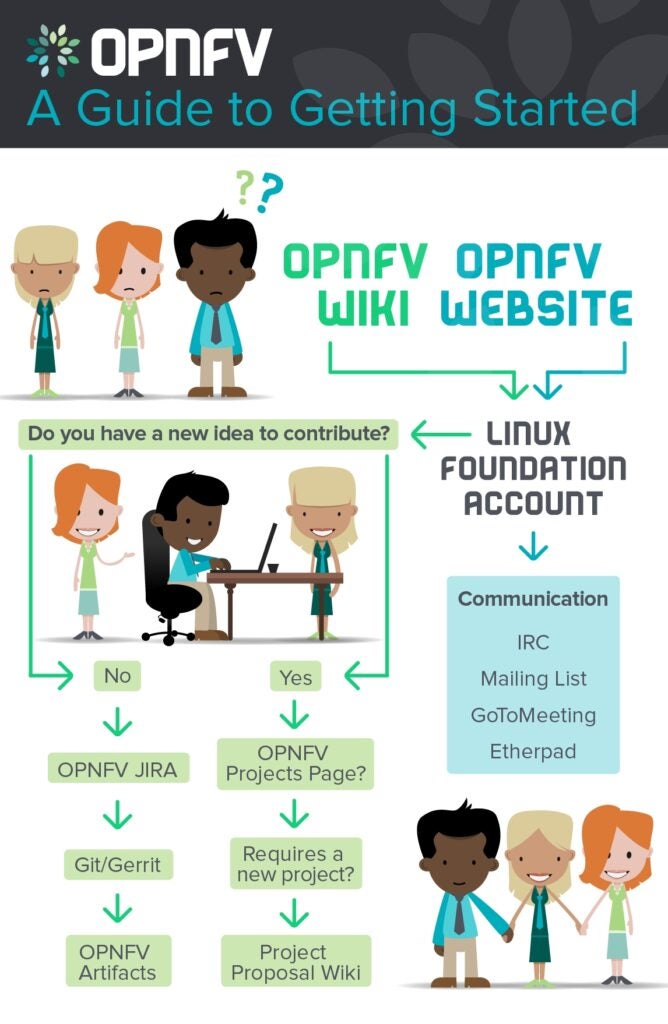Thank you for your interest in the OPNFV Community! To make getting started with the community a smooth process, this post will guide you through the basics of our resources, projects, tools, and processes.
 OPNFV consists of multiple projects focusing on everything from hardware management to KVM enhancements to running applications. We work closely with underlying upstream projects to help accelerate NFV via an integrated, open platform. Beyond new features, our main focus is integrating of open source components into the platform with proper verification and validation. We have several projects designed to to drive upstream implementation and provide hardware infrastructure, tool sets, testing frameworks and so forth. Furthermore, we encourage every participating member to use Agile methodologies as we believe in speed, proactivity and flexibility. If you would like to learn more about OPNFV in general before jumping in, feel free to reference the OPNFV website or take a look at the OPNFV Wiki.
OPNFV consists of multiple projects focusing on everything from hardware management to KVM enhancements to running applications. We work closely with underlying upstream projects to help accelerate NFV via an integrated, open platform. Beyond new features, our main focus is integrating of open source components into the platform with proper verification and validation. We have several projects designed to to drive upstream implementation and provide hardware infrastructure, tool sets, testing frameworks and so forth. Furthermore, we encourage every participating member to use Agile methodologies as we believe in speed, proactivity and flexibility. If you would like to learn more about OPNFV in general before jumping in, feel free to reference the OPNFV website or take a look at the OPNFV Wiki.
If you’d like to jump right in, the absolute first step is to create a Linux Foundation account and visit the tools page where you will find links to all of the developer tools available. (Note, in most cases you will only have read rights, but once you begin to contribute to a project you will get the access you need to get started.)Our community believes in coordination and well organized activities as well. This means that we plan and track our tasks within each project around the theme of releases. More detailed information about our project plans are documented in Jira, which can be a good resource to reference tasks or find issues to work on. If you’re not familiar with this tool, check out the Getting started web page for guidance.
You may have heard that OPNFV is a “mid-stream community” which is not supposed to carry any code on its own. It actually depends on how you define “code.” Let’s use the word “artifacts” instead, which includes test cases, documentation, integration scripts and so forth. The common integration point is Git, which we use for version control. You should also familiarize yourself with Gerrit; via the OPNFV Gerrit you can access repositories and provide patch reviews. You’ll need to set-up a few things to get started with Gerrit, like your email address, and you should also not forget to sign the CLA! Without that you will not be able to submit a patch. You can also access our artifacts page for some results and check out project documentation or even ISO images.
As with every other open source community, we have several channels for communication. These include weekly meetings, mailing lists and IRC channels for daily text-based discussions. The Meetings wiki page contains an up- to-date list of meetings, including agendas and all the information required for joining. We use GoToMeeting for voice and also the #opnfv-meeting or project IRC channels on Freenode for meeting minutes. You can join to the development activities, raise topics for discussion or ask questions on the opnfv-tech-discuss mailing list, which like all the other lists, is also archived.
And last, but not least, the most important thing among all, if you would like to meet with the eager fellow developers, keep an eye on the Events web page for the list of upcoming events, where you can find us.
“That’s all folks!”
Stay tuned for more, and thank you for joining to this short tour of OPNFV! I hope to see you again on a project meeting, on IRC or even at the next, and very first, OPNFV Summit!
About the author of this post


 Ildikó Váncsa
Ildikó Váncsa